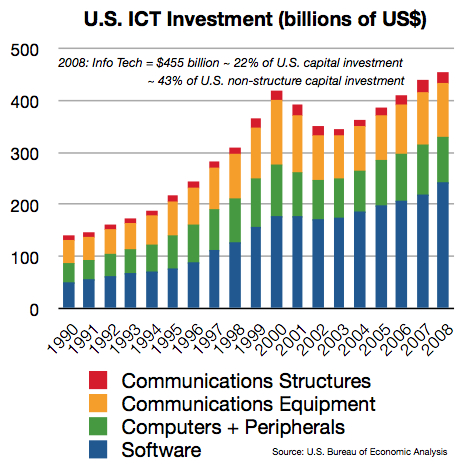Lots of commentators continue to misinterpret the research I and others have done on Internet traffic and its interplay with network infrastructure investment and communications policy.
I think that new video applications require lots more bandwidth — and, equally or even more important, that more bandwidth drives creative new applications. Two sides of the innovation coin. And I think investment friendly policies are necessary both to encourage deployment of new wireline and wireless broadband and also boost innovative new applications and services for consumers and businesses.
But this article, as one of many examples, mis-summarizes my view. It uses scary words like “apocalypse,” “catastrophe,” and, well, “scare mongering,” to describe my optimistic anticipation of an exaflood of Internet innovations coming our way. I don’t think that
the world will simply run out of bandwidth and we’ll all be weeping over our clogged tubes.
Not unless we block the expansion of new network capacity and capability.
The next line of attack is to use the words of the expert analyst Andrew Odlyzko to “debunk” a point they have just invented.
According to Odlyzko, the current Internet growth rate of about 50% per year “can be accommodated with essentially the current level of capital investment.”
But this entirely misses the point. Why? Because the “current level of capital investment” is absolutely huge. And it is not a given — it is not automatic — that dozens of communications companies in a highly competitive, fast-moving broadband world can sustain the “current level of capital investment” if big obstacles are thrown in their path. In fact, it’s highly improbable.
In 2008, the U.S. invested $455 billion in information and communications technology. Things like computers, software, routers, switches, fiber optics, and cell towers. That was about 22% of all U.S. capital investment and an amazing 43% of all U.S. non-structure capital investment. We invested $127.3 billion in communications equipment alone (real private fixed investment; 2000 constant dollars). Communications service providers account for the bulk of this, investing about $70 billion per year.
It’s easy, with useful and entertaining Internet innovations popping up all around us, to just assume these modern miracles will continue flowing. But new productivity-enhancing technologies like cloud computing do not just appear out of, er, thin air. They require hundreds of billions of dollars worth of risky investment in support of speculative business plans in markets that are changing faster than any markets ever have.
The most reliable way to block the future is to assume it will happen. We have to make it happen.


